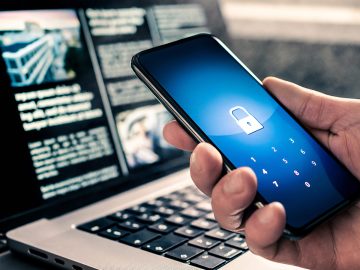Even though the internet is a great place, most online services require you to create an account and use a username or email address and password to verify yourself and log in. Sometimes these passwords are complex and relatively secure, but others are scarily simple. That said, hackers can crack even the longest passwords. Thankfully, there’s a solution: With two-factor authentication (2FA), you can really boost your security, making it difficult for cybercriminals to access your data. Read on to learn what 2FA is, what its pros and cons are, and what the different types are. Also discover how Avira Password Manager can further increase your security.
Your 101 guide to why you need two-factor authentication
2FA is a process that includes an additional, independent step to identify and authorize yourself. Here, the traditional way of logging in using a username and password is supplemented by a second factor, such as a one-time code on your smartphone or a biometric scan like your fingerprint. Since this additional step is required no matter which device you’re using to log in, it’s very difficult for hackers to break into the login process or get at your sensitive data.
The aim is that thanks to 2FA, only authorized users have access to sensitive data and user accounts. An example of classic two-factor authentication is the generation of an additional code that’s required to confirm your identity during the login process. As soon as a user logs in with their credentials on a website or in an app, the additional code is emailed, text, or sent via an authenticator app.
What are the pros of two-factor authentication?
Two-factor authentication has clear advantages that make it an indispensable part of your IT security. These benefits include:
- Increased security: The two independent verification methods (password and 2FA code) significantly increase the security of the login process.
- Protection against data breaches: Dedicated hacking attacks are increasingly targeting major internet portals. In such data breaches or data leaks, cybercriminals gain access to huge amounts of data, often including users’ login information. Thanks to 2FA, you have enough time to change your credentials without worrying about your personal information being misused.
- Trustworthiness: Sites, services, and companies that rely on two-factor authentication come across as more trustworthy as bastions of user safety.
- Convenience thanks to variety: There are various methods of two-factor authentication to complement the traditional login process. Whether via text, push notification, authenticator app, or biometrics, you can choose a way that is most convenient and easiest for you.
What are the cons of two-factor authentication?
First of all: Despite some minor hassle, always bear in mind that two-factor authentication significantly increases your security, outweighing any potential cons. To get a complete picture, let’s look at the possible downsides:
- More effort to log in: The additional step means you have to do yet another thing instead of simply just logging in with your user ID and password. That’s because the process takes longer as you first need to receive a code and enter it.
- Access to the 2FA device: 2FA usually requires another trusted device. In most cases, it’s your smartphone. If you don’t have it readily available, you won’t be able to log in.
- Always online: You don’t just need to have your smartphone close to hand — you also need a reliable internet connection. Depending on the method, you need to make sure that your device has reception (for text messages) or internet access (for your authenticator app).
- Risk of being locked out: If you lose your device or it gets broken, you’ll no longer have access to your online accounts. With 2FA, you always run the risk of locking yourself out and temporarily losing access.
What’s the difference between 2FA and MFA?
You may have already come across the abbreviation MFA, especially in the context of 2FA as they’re very similar terms. The difference between the two lies in the number of factors you use to identify and authenticate yourself.
- 2FA: As we know, this stands for two-factor authentication. In addition to the combination of login name and password, an additional factor or login step is required. Examples include a combination of password and text code.
- MFA: This stands for multi-factor authentication. This term includes 2FA, but can also cover three or more steps. Examples include a combination of password, fingerprint, and text code.
Whereas two-factor authentication is used mainly by private individuals, companies with more stringent security requirements rely on multi-factor authentication.
How does two-factor authentication work?
There are multiple ways to enhance the security of your accounts by using two-factor authentication. Read on for the most common options and how they work.
Text verification
Text verification is probably the most common form of two-factor authentication. All you need to do is enter your mobile phone number in your user account. Once you’ve turned on verification via text code, you’ll be text a randomly generated sequence of numbers the next time you log in.
Authenticator apps
Authenticator apps are another very popular method. These apps are a more secure alternative to text verification because the code is generated directly on the device and doesn’t need to be transmitted. This makes it much more difficult for hackers to intercept the sequence of numbers.
In addition, once the (usually six-digit) code is generated, you need to use it within a short period of time. In most cases, after 30 seconds the code becomes invalid and a new code is generated. The most popular apps include Google Authenticator, Microsoft Authenticator, and Authy.
Push notification
Authentication via push notification is one of the most convenient methods. As soon as you log in to your user account, you’ll receive a push notification on your registered device (usually a smartphone or tablet) informing you of the login attempt. With a simple tap on the notification, you authorize the login and don’t need to request or enter any additional codes.
Voice-based authentication
This form of two-factor authentication is similar to a push notification. In this case, a computer-generated voice prompts you to do something. Typically, you have to press a certain key/button or say your name.
Hardware token
A hardware token is a physical device — think of it like a security key — that functions as a standalone tool. This key is either connected via USB or works completely autonomously. Such devices continuously generate codes and don’t require an internet connection to operate. Many tokens can also be secured with an additional PIN. This makes hardware tokens a particularly secure form of two-factor authentication.
Biometric authentication
Authentication using biometric data brings a new level of security to the user identification process. More and more, your face or fingerprint is being used as a way to identify you — just think about how you unlock your smartphone or do online banking. Biometrics often replaces the classic password, making the verification process quick and easy.
Add an extra layer of protection to your user accounts with Avira Password Manager
You significantly increase the security of your account by turning on two-factor authentication. Hackers and cybercriminals have a much harder time trying to break in and gain unauthorized access. For additional protection, always use long, complex passwords that are difficult to guess and crack. The more complicated, the better. A mix of special characters, upper and lower case letters, and numbers is best.
Ideally, also use a unique password for each user account. To assist you, Avira Password Manager helps you keep track of things. The tool stores all your passwords and helps you generate super-secure combinations. You only have to remember the master password for the app — Avira Password Manager takes care of the rest.














